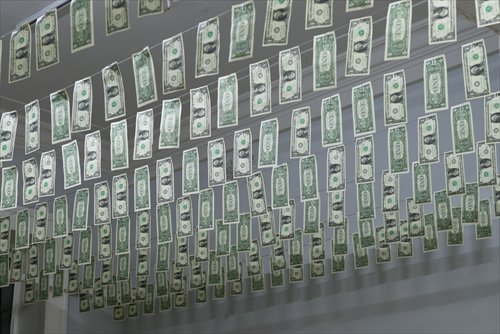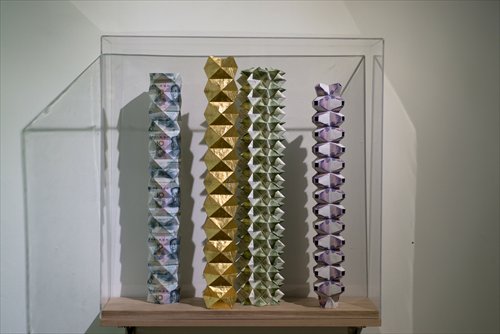Capital gains
Art show looks at aftermath of financial crisis
Vive Le Capital, an ongoing group exhibition held at BANK gallery, explores the power of global finance.
Wang Xin, who is curating the exhibition along with Christoph Draeger and Mathieu Borysevicz, said the exhibition is inspired by the current state of the world economy and the aftermath of the financial crisis.

An exhibit on display at BANK Photos: Courtesy of the gallery
"Many artists who chose to respond to this incredibly complex reality, which brings us both disasters and betterment of life, seem to either naively adopt a moral stance by considering themselves as an outsider to the system, or fail to provide more daring means of engaging with the inescapable reality," said Wang.
Through this exhibition, Wang aims to show a wide range of thoughts and strategies rather than explain facts and phenomena.
"The exhibition is an expression of experiences with global capital, whether from a formal point of view or a poetic one. It is a way of articulating and inquiring about the omnipotence of capital in our lives," said Mathieu Borysevicz, who is also the owner of the gallery.
The show is made up of 23 works from 10 countries, each of which approaches the idea of capital from a different angle. Materials used include bank notes, installations, photos and movie clips. The oldest piece in the exhibition dates back to the 1970s, while the most recent was created a few months ago.
Some of the exhibits focus directly on the role of money and are specific to this city. In one piece, named The New China (pictured below), Spanish artist Javier Viver presents some models of futuristic buildings created using Chinese currency.

Making the models took the artist three weeks. One is coated in 24-carat gold to illustrate the expense and luxury of the skyscrapers. Viver said that when he first came to Shanghai 18 months ago, he was amazed to see high towers next to low-rise buildings, and how older buildings were abandoned in favor of the newer ones. "I think we need to take care of the history because it is the story and the cultural identity of the city," said Viver.
Some exhibits take a more poetic look at capitalism. The installation Stars and Constellations by Belgian artist Heidi Voet consists of thousands of coins of various sizes and colors scattered across a stage, twinkling like stars in the night sky. The installation was originally designed for an exhibition about the euro at the EU building in Brussels.
There are about 4,000 coins in the piece from a number of countries, including the US, China and a number of developing countries.
"There is a lot from China because it represents a strong economy. I also chose some older coins from the US molded in the 1960s and the 1980s when the dollar was extremely important to show the shift in the world economy," Voet said.
"The only thing that is not real is the euro," said Voet, who had replicas made in China. While they look like euro coins, they are made with a different metal, and have one star less than on the EU symbol. The flip sides, which would normally carry a country-specific symbol, are blank. This, Voet says, is to show that the euro has "lost face."
Voet often fuses her quirky assemblages and images with a luminous sense of feminism and pop cultural motifs.
"The relationship between currency and art is as elastic as the stretch of the imagination. There's a variety of attitudes as well as a variety of methodologies. We wanted to make an exhibition that's relevant, critical and fun," said Wang Xin.
Date: Until May 24, 10:30 am to 6:30 pm (closed Mondays)
Venue: BANK
Address: 1/F, 59 Xianggang Road
香港路59号1楼
Admission: Free
Call 6301-3622 for details
Global Times